You might think your product is the best thing since sliced bread.

But that doesn’t count for anything unless you’ve got the product reviews to back it up, with research from Trustpilot revealing that nine in ten people read customer reviews before committing to a purchase.
“No problem,” you might think. “I already have a bunch of reviews.”
Unfortunately, if they’re not recent, they’re not doing much good.
According to Bright Local, 69% of buyers only pay attention to online reviews written within the past three months, while only 7% say review recency doesn’t affect their decision-making.
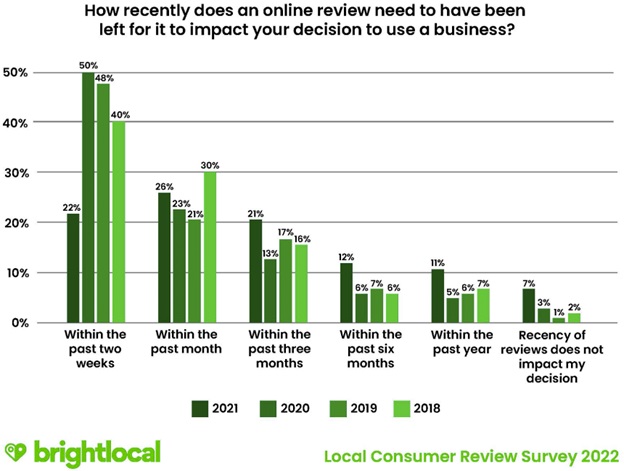
Wondering how to get your products reviewed?
Want to build a reviews outreach strategy for product promotion?
Read on to learn the answers…
Why You Should Always Look For More Product Reviews
Okay, so reviews are good.
But what specific benefits can you expect from stepping up your reviews outreach?
From our experience, the five biggest “wins”, in no particular order, are:
- Driving conversions
- Growing traffic to your website
- Informing your product roadmap
- Building trust and authority
- Increasing sales
How Do Product Reviews Get You Traffic?
One of the lesser-known benefits of generating online reviews from customers is that it can boost traffic to your website.
According to review technology company PowerReviews, its clients enjoy an average 108% lift in impressions for individual products when their number of reviews rises from zero.
And more search impressions means more traffic.
What’s more, third-party review sites can be a major source of traffic from referrals.
A prospective customer reads a review on a site like Better Business Bureau, Google My Business, or Trustpilot, likes the sound of your product, and clicks through to your website to learn more.
As an added bonus, this traffic is likely to be highly qualified, because it’s full of people who are actively searching for products like yours.
Gathering positive reviews from sources trusted by consumers is a tactic used by many of the most well-regarded SaaS companies, including Hunter, Zendesk, and Crisp (a leading Zendesk alternative). In other words, it’s a strategy that’s proven to work, so you’d be a fool not to use it!
Can Product Reviews Help Get Better Conversions?
In a word: yes!
The more current product reviews you have, the higher your conversion rate will be.
Another study from the clever folk at PowerReviews revealed a direct, linear correlation between the number of reviews on a product page and the conversion rate of that page.
When individual products have 1 – 10 customers, they see a 52.2% increase in conversions compared to pages with zero displayed reviews.
And that climbs to a staggering 251.2% increase for pages with 101+ product reviews on display.

Can Product Reviews Build Trust And Authority?
Customer reviews make you and your products look more trustworthy — provided they’re honest reviews.
Buyers are smart.
They’re very aware that fake reviews exist, to the extent that a smattering of negative feedback can actually be a good thing.
Why? Because it makes you look more legit (I’ll talk about this in more depth later).
On a related note, a positive review from an influencer can have a huge positive impact on your trust and authority.
Indeed, Matter Communications found that three-fifths of consumers trust social media recommendations from a friend, family member, or influencer.
In contrast, less than two-fifths are likely to trust recommendations from brands themselves.
How Do Product Reviews Help You Upgrade Your Product?
A simple point, but one that’s definitely worth making:
Asking bloggers, influencers, and customers for reviews gives you a ready-made way to gather product feedback.
That feedback can be an absolute treasure trove of information that can give you a steer on how best to improve your product.
Do lots of your customers wish you offered a specific feature or integration?
Have multiple reviewers highlighted a glitch?
Add those upgrades to your product roadmap and you could see an uptick in customer satisfaction and retention.
How Products Reviews Can Increase Your Sales
Last, but by no means least, customer reviews for products can have a big impact on sales.
That impact is most often indirect.
Don’t expect would-be customers to read one review, then immediately buy your product.
But “indirect” doesn’t mean “insignificant”, with research from Reevoo finding that product reviews lead to an average 18% upturn in sales.
That’s almost one-fifth more sales, simply from encouraging people to rate your products.
Sounds like a pretty good trade, right?
10 Ways To Get More Product Reviews Fast
Hopefully, I’ve persuaded you that generating more current product reviews is an absolute no-brainer strategy.
Now, let’s look at how to quickly boost your reviews of products.
1. Look For Influencers
I’ve already pointed out how influencer reviews can be extremely impactful, increasing trust in your product and making your brand look more authoritative.

Problem is, finding influential influencers can be difficult.
Not least because all your competitors are looking for them too.
So it pays to cast the net as wide as possible.
Fortunately, Postaga makes it simple.
Our tool comes with a built-in prospecting mechanism that helps you track down influencers in your niche
And as an added bonus, it also includes links to their LinkedIn and Twitter accounts, so it’s quick and easy to reach out and start a conversation.
Building relationships with influencers has a ton of benefits, getting you in front of audiences on multiple platforms, including:
- Blogs
- YouTube
- Podcasts
One more point on this:
Once you’ve struck up a relationship with an influential blogger, you can leverage it to run guest post campaigns, giving you yet more opportunity to promote your product on a high-profile platform.
2. Run Giveaways
The power of word-of-mouth marketing simply can’t be overstated.
One study claimed consumer word of mouth — in the form of offline and online reviews, recommendations, and conversations — accounts for an astonishing 13% of all consumer sales, equivalent to $6 trillion in annual spending.
And what better way to leverage word of mouth than by giving people free (or heavily discounted) access to your product?
Not only can it get your product in the hands of a bunch of people who might otherwise not have used it, but it also has the potential to encourage other reviewers to try it out — and review it — themselves.
This is a tried-and-trusted approach in the SaaS world.
For instance, when Postaga launched on Product Hunt, it had a free tier, and signed up 1,000 users in 1 week.
We treated it like any other marketing channel. In that week we did the Product Hunt launch, we went from being completely unknown to having a sizable user base talking about and sharing our product.
3. Find Competitor Product Reviewers
I bet your competitors are actively seeking out product review opportunities too.
So why not benefit from their hard work by asking websites and bloggers who’ve reviewed their products to review yours as well?
Again, Postaga can help here.
We have a built-in automation for setting up email sequence campaigns for reviews outreach. It lets you:
- Find publishers who’ve reviewed your competitors’ products or services
- Connect with those websites on LinkedIn and Twitter to get on their radar and build a relationship
- Reach out to them via email to suggest they review your product or service
As with everything in the world of cold outreach, it’s a numbers game.
Not all the sites you reach will agree to your review requests.
But it stands to reason that the more publishers you connect with, the more reviews you’ll generate.
Helpfully, Postaga doesn’t just offer a one-size-fits-all solution for gathering product reviews.
In fact, we offer three distinct “flavors” of reviews outreach:
- “Classic” reviews outreach campaigns are what I’ve already described in this section.
- Tools outreach campaigns help you find websites that share their favorite tools in your niche (e.g. 15 Best Email Marketing Tools) and ask them to add your product to their recommended list.
- Vs outreach campaigns are about tracking down publishers that compare your competitors’ products with other options on the market (e.g. HubSpot vs. Hootsuite) and asking them to do a comparison of your product.
As you can likely imagine, combining those three strategies can win you a wealth of extra reviews.
It’s not out of the question to get all three — a product review, a mention on a “recommended products” list, and a feature in a comparison article — from the same publisher.
4. Deploy Affiliates
For in five US advertisers use affiliate marketing as part of their promotional strategy.
Why?
Because it’s a fantastic way to gather more current product reviews and generate a ton of extra sales.

For the unfamiliar, affiliate marketing involves working with third-party sites and creators — AKA affiliates.
They’ll promote your product through reviews and recommendations.
When a customer reads a positive review for your product on an affiliate site, clicks through to yoursite, and makes a purchase, you pay them a commission for the privilege.
More product reviews and revenue for you; passive income for them. It’s a win-win.
Postaga is the perfect tool to deploy affiliates.
I’ve written a whole in-depth guide on finding, connecting with, and managing affiliates, so I’m not going to discuss it at length here.
But it’s basically about building an email list of affiliate marketers that promote your competitors’ products…
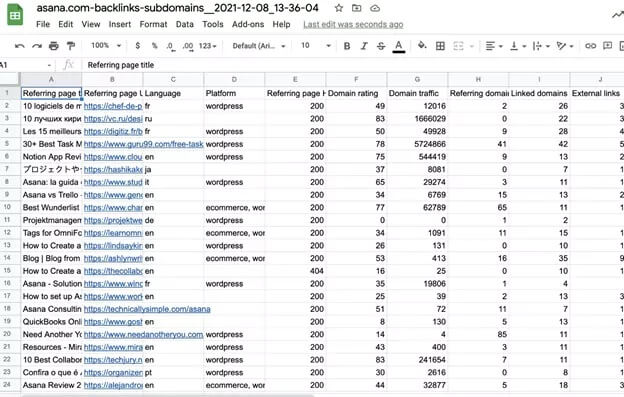
…and using Postaga to reach out to them with a personalized pitch email sequence.
5. Promote Your Product Via Digital PR
Digital PR is another highly impactful way to promote your product through reviews and recommendations.
In short, it’s about connecting with websites and encouraging them to create content about your product.
Whereas “traditional” PR relies on building relationships with journalists to get your company or product featured on TV, radio, or in print publications, the digital variety includes a wealth of additional opportunities, such as:
- Landing podcast appearances
- Collaborating with high-profile social media accounts
- Being featured on media websites
Again, Postaga can help here, making it easy for brands to find journalists’ email addresses and craft compelling pitches that drum up excitement about your product.
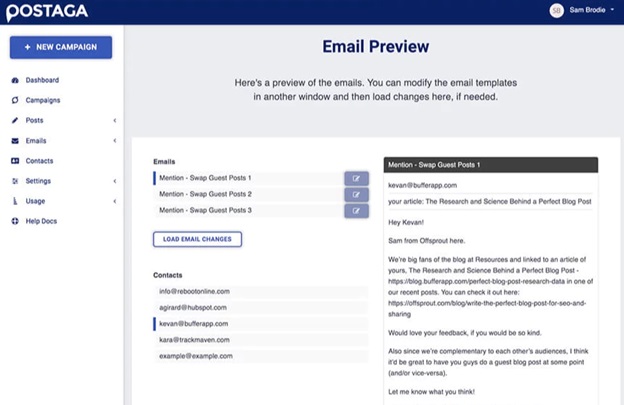
The word “compelling” is extremely important here, with research from Propel revealing that journalists only open 3% of the media pitches they receive.
If you don’t stand out from the crowd, don’t expect time-poor journos to bother reading your pitch.
6. Utilize YouTubers
YouTube isn’t just the go-to place for getting into an argument in the comments section of your favorite music video.
For many buyers, it also plays a big role in influencing purchasing decisions, with Google’s own research showing that more than 40% of global shoppers have bought products they discovered on YouTube.
What’s more, evidence suggests people prefer video reviews to their text-based equivalent.
Gathering data from more than 324,000 videos, Wyzowl discovered that when both text and video elements are available on the same page, 72% of consumers would rather learn about a product or service by watching the video.
So it makes sense to include YouTubers in your reviews outreach strategy.
Prospecting for the right YouTubers is doable, but it can be pretty tricky. In particular, collecting emails is a lengthy process.
There are various tools that claim to do the job, but if you don’t want to pay for an email scraper, you’ll need to find them manually by trawling through their social profiles and hoping they’ve added an email in their bio.
Once you’ve manually collected those emails, you can use Postaga to build cold email campaigns and reach out to your chosen YouTubers to ask for video reviews of your product.
7. Incentivize To Get More Product Reviews
This approach is similar to running a giveaway, but rather than offering free access to your product in the hope that it leads to lots of positive word-of-mouth sentiment, it involves providing incentives in exchange for reviews.
You might feel a bit… uneasy about this approach.
Like you’re essentially “buying” positive feedback from users.
But product reviews are a marketing strategy, just like running ads on social media or bidding on keywords in search.
So why not allocate some of your marketing budget to gathering reviews?
The incentive you offer is ultimately up to you, but options include:
- Free access to your product
- Discounted monthly subscription
- Entry into a prize draw
8. Display The Reviews
Sure, it doesn’t take much time to write a short product review.
But it’s still time that could have been spent doing something else.
So if your customers are prepared to make that sacrifice, the least you can do is actually make use of their work by displaying it on your website.
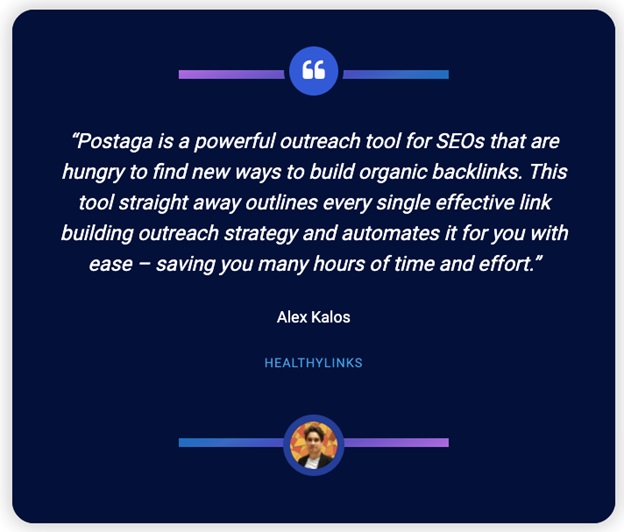
Some of those reviews might be especially complimentary or entertaining, in which case it makes sense to share them on your socials too.
Just be sure to first reach out to the reviewer to say “thanks” and ask permission to share their glowing words.
9. Make It Easy To Write Reviews
This might sound like an obvious point, but trust me, a lot of brands overlook it.
Simply put:
It should be as easy as possible for customers to leave product reviews.
The simpler the process, the more reviews you’ll generate.
Conversely, if customers have to dig four pages into your website to publish a review, don’t expect them to bother.
There are lots of different ways to approach this problem, but arguably the easiest is to add a review request landing page to your website — a single place that explains how your customers can leave feedback.
It might incorporate a review form, or maybe it’ll include links to your favored third-party review sites.
10. Post Purchase Follow-Up Email For Reviews
Like the previous point, this is a massive opportunity that lots of companies aren’t taking full advantage of.
The idea is that every time someone buys your product, you send them an automated follow-up email asking for a review, just like TradeGecko does here:
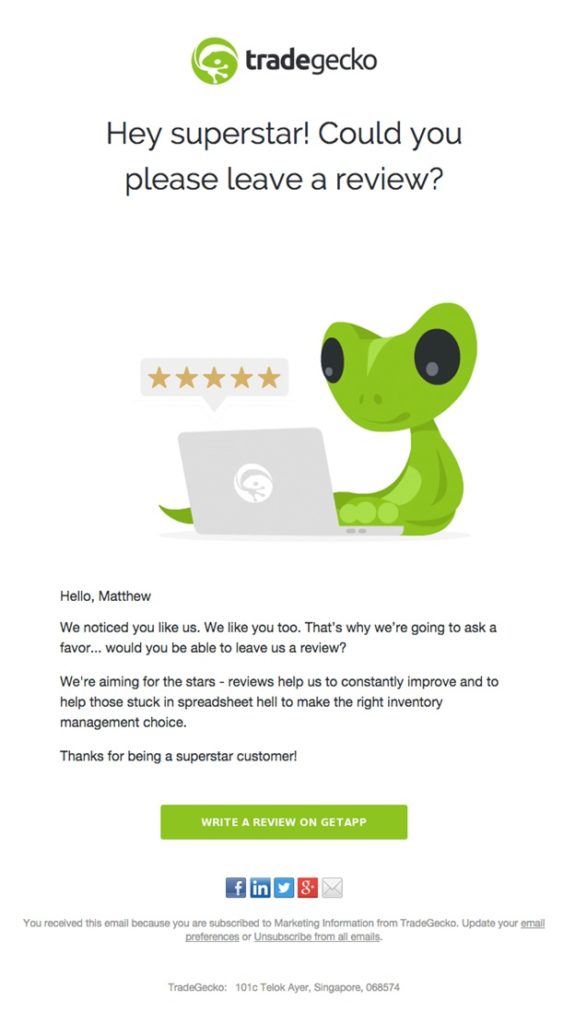
The best thing about this approach is that it’ll help you gather product reviews from your newest customers.
And your newest customers often leave the most meaningful reviews.
Why? Because they’ve only just been through the path to purchase.
That means they’ve recently encountered the exact same pain points as a prospective customer who’s currently weighing up whether to buy your product.
So their words will have a lot more impact than a dyed-in-the-wool veteran who’s been using your product for years.
How Do Negative Reviews Help?
Counterintuitive as it might sound, the occasional negative review can actually do you some good.
Thing is, we consumers are a suspicious bunch.
If a brand has a perfect five-star rating, they’ll naturally assume they’re all fake reviews.
This isn’t just my opinion; it’s supported by cold, hard data.
PowerReviews and Northwestern University analyzed reviews for more than 111,000 products across 22 categories and discovered that purchases are most likely when the average star rating is between 4.2 and 4.5 stars.
Any higher and our spidey-sense starts tingling.
What’s more, bad reviews can help you find elements of your product that are in need of improvement.
So don’t bury your head in the sand or sulk when you get a negative review; embrace it and (where necessary) take action.
That’s All Folks!

If you only remember one thing from this article, let it be this:
People love reviewing movies and music.
They’re less keen to rate email marketing solutions or project management tools.
So if you don’t actively run reviews outreach campaigns, you’re not going to generate many (or any) reviews.
Luckily for you, Postaga makes reviews outreach quick and painless.
To see for yourself, sign up for our 14-day free trial.
Maybe you could even leave us a review after!
Free 14-Day Trial
Start building relationships now with your fully-featured 14-day trial!
How We Compare
Terms | Done-For-You Terms | Privacy | Write For Us | Press
© 2026 Postaga. All Rights Reserved. Made with 
